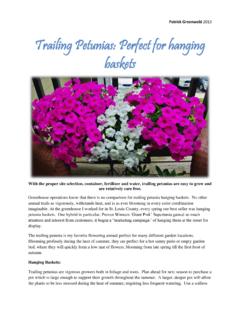Transcription of GROWTH RETARDANT APPLICATIONS TO …
1 1 GROWTH RETARDANT APPLICATIONS TO petunia LINERS. Internal Report for Young Plant Center Research Partners. Not for publication or reproduction in part or full without permission of authors. Copyright, October 15 2007. By Paul Fisher, Ernesto Fonseca and Jim Barrett (University of Florida), and John Erwin (University of Minnesota) Objectives: (a) To compare location differences in the elongation and flowering response of GROWTH retardants. (b) To develop a protocol for accurate on-site GROWTH regulator trials.
2 Benefits: Quantify how much variation in height control results from GROWTH retardants applied to liners at several locations in the We developed a detailed protocol, which could be used as a model for training growers to run effective GROWTH regulator trials. We also provided a kit of materials that could be used for accurately running small-scale trials in the future. Experimental Design: The overall approach was to root liners of one petunia variety at Cole Growers in Loudon , and then ship these rooted liners to multiple grower locations and two universities.
3 The GROWTH retardants were applied to rooted liners at each location, liners were transplanted into 4-inch pots, and subsequent GROWTH and flowering were recorded. PHASE 1, PREPARING LINERS AT COLE GROWERS IN : On week 11 (Mar 12) a single vegetative petunia cultivar (Cascadia Champagne which is a trailing medium-vigor cultivar) was stuck at one location ( Cole Growers) in 25-count strip trays with Preforma growing medium (supplied by Pleasant View Gardens).. A weather station (provided by UF) was placed in the same greenhouse at Cole Growers where the trays were located, and measured average temperature and daily light integral.
4 Until week 14 (Apr 2) plants were grown under natural day lengths. No GROWTH regulators were applied while liners were being rooted at Cole Growers, and plants were not pinched. On week 14 (Monday, Apr 2), the liners were shipped to each grower and university location. PHASE 2, AT EACH GROWER LOCATION, ON RECEIVING ROOTED LINERS Each grower was supplied with: A data logger to record air temperature and light level An Excel spreadsheet and paper data sheet to enter air temperature and light level Labels for each liner tray and pot An electric sprayer and 50 milliliter cups for applying GROWTH RETARDANT sprays in low quantities.
5 Instructions on dilution rates to achieve the desired ppm. Containers and an electronic scale for measuring GROWTH retardants A plastic bin for dipping the liners A crop record sheet to record dates for GROWTH RETARDANT APPLICATIONS and transplant, and fertilizer concentration An Excel spreadsheet and paper data sheet for entering shoot lengths and flowering dates 2 On receiving the liners on week 14 (Apr 2), liners were placed out in the greenhouse. Plants were grown on as normal for one week to acclimate to local conditions.
6 Treatments applied on week 15 (Apr 11) included: An untreated control Three Bonzi dip rates: ; ; and ppm Two B-Nine spray rates: 2,500 and 5,000 ppm Two Sumagic spray rates: 10; 20 ppm One other optional treatment (decided by each grower, described below) Optional Grower Treatments that were selected at each location Location Chemical and Concentration Application method Altman s, Cal. Florel 500 ppm Spray Costa, Fl. Topflor 50 ppm Spray Cole Growers, Florel 125 ppm Spray Four Star, Mich.
7 Sumagic 30 ppm Spray Glass Corner, Mich. Topflor 2 ppm Dip Pleasant View Gardens, Bonzi 2 ppm Drench Smith Gardens, Wash. B-Nine 2500 ppm/Cycocel 1000 ppm Spray Wagners, Minn. A-Rest 40 ppm Spray Welby, Col. A-Rest 10 ppm Spray University of Florida Sumagic 1 ppm Dip University of Minnesota Sumagic 1 ppm Dip Two days after treatment, on Friday April 13, liners were transplanted into 4-inch-diameter standard pots. On week 17 (Wed April 25) and week 19 (Wed May 9), growers recorded the shoot length (soil surface to longest shoot tip).
8 From weeks 14 to 23 (Apr 2 to June 4), no GROWTH retardants other than the experimental treatments were applied. Plants were grown on under normal grower conditions and natural day lengths, with no additional GROWTH RETARDANT treatments other than the experiment. Fertilizer concentration, and pesticide APPLICATIONS were recorded on a crop record sheet. Once a week, daily light and temperature data were downloaded onto the spreadsheet. Twice a week from week 16 onwards, growers checked plants for flower date, which was recorded on the data sheet.
9 The flower date was the first date when a plant had an open flower. Days to flower were calculated as the number of days from when plants were received until their open flower date. Results: Results are presented in a series of charts and maps on the following pages, summarizing effects of location and GROWTH RETARDANT on shoot elongation and flowering. In the top right of each chart, there is a short summary of important trends. A few example photos are also shown from the University of Florida and Altman Plants locations.
10 3 Example photos from the trial Relative size of plants 14 days (Top) or 28 days (Bottom) at the University of Florida location. At two weeks, plants from all treatments were noticeably more compact than the control. By 4 weeks, plants receiving BNine were already very leggy, and only plants receiving the higher Sumagic spray and dip and Bonzi dip rates were somewhat compact. By time of open flower (35 to 39 days), all plants were unacceptably leggy. Control Sumagic 10 ppm spray Sumagic 20 ppm spray Control BNine 2500 ppm spray BNine 5000 ppm spray Control Sumagic 1 ppm dip Control Bonzi 1 ppm dip Bonzi 2 ppm dip Bonzi 4 ppm dip Control BNine 2500 ppm spray BNine 5000 ppm spray Sumagic 10 ppm spray Sumagic 20 ppm spray Bonzi 1 ppm dip Bonzi 2 ppm dip Bonzi 4 ppm dip Sumagic 1 ppm dip 4(A) (B) Petunias from Altman Plants (Vista, California), 55 days after GROWTH RETARDANT APPLICATIONS .









